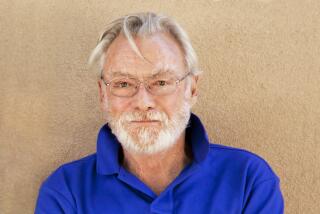M. Pynoos, 84; Civic Booster, Engineer
- Share via
He laid out a prewar airfield, designed the first nail gun to help Howard Hughes make the Spruce Goose, built the historic One Wilshire building and created a glass-walled art center to celebrate “60 Years of Living Architecture” next to the Frank Lloyd Wright-designed house in Barnsdall Park.
He also dreamed up computerized corporate carpooling, funded research into major eye diseases and persuaded artists such as David Hockney to contribute art to benefit the Los Angeles Children’s Museum.
Morris S. Pynoos, the engineer, contractor, philanthropist, art collector and civic booster known as “Morry” to friends and readers of the late Times columnist Jack Smith, died Friday at Cedars-Sinai Medical Center of congestive heart failure. He was 84.
A native New Yorker, he came to Los Angeles with his family when he was 5, delivered produce for his father’s Depression-era grocery store, graduated from Fremont High at 16 and earned a civil engineering degree from UC Berkeley in 1939.
Involved in U.S. defense efforts before World War II, he laid out the airfield at Inyokern, which became the China Lake Naval Weapons Center. During the war, he worked as an aeronautical engineer at Curtis Wright, Lockheed and Hughes Aircraft, helping to design the XP-55 Ascender, the giant C-46 Cargo Transport and the experimental photo reconnaissance XF-11 aircraft.
Pynoos designed the now-ubiquitous nail gun specifically for Howard Hughes’ famous Spruce Goose. The wooden fuselage was nailed together and glued, and then the nails were removed. According to his son Robert, Pynoos knew the huge aircraft would get off the ground--which it did, once--but said it could never be properly maneuvered aloft.
After the war, the engineer formed Morris S. Pynoos Co. to build innovative custom homes and other structures by well-known architects, including Wright and Paul Williams. He built many showplace homes in the 1950s with free-standing, movable and glass walls, as well as the Barnsdall Park Art Center.
Pynoos became intrigued with quake-resistant construction techniques when his family home remained the only one in his neighborhood left standing after the 1933 Long Beach earthquake.
As president of Rockwin Prestress Concrete Corp. in partnership with Winthrop Rockefeller in the 1950s, he developed prestress concrete--casting concrete around steel cables stretched by hydraulic jacks that were released as the concrete hardened. The material proved useful in fabricating wide-span beams, floors and bridges.
In the 1960s, Pynoos, as vice president of S. Jon Kreedman Co., built the 31-story One Wilshire in downtown Los Angeles, the first city skyscraper taller than the previous earthquake-safety height limit of 13 stories. The construction incorporated the latest technology in seismic joints and rockers to withstand shaking.
In 1966, as chief of staff for the Westwood Village Development Co., Pynoos helped renovate the commercial area adjacent to UCLA and encouraged the addition of movie theaters and high-end shops to attract consumers. He helped persuade federal officials to add a Westwood exit to the San Diego Freeway to increase traffic to the area.
Pynoos also built a number of bank buildings, including the United California Bank in Beverly Hills and more than a dozen American Savings banks throughout California. Later, he moved into owning and managing commercial and apartment complexes as a partner in P and M Realty and Century Development.
In 1962, Pynoos conceived a corporate carpooling plan he called “Community Auto Rides” to reduce air pollution and crowded downtown Los Angeles traffic.
His idea, ahead of its time, has become commonplace with the development of more sophisticated computers and corporate incentives to employees.
Pynoos’ interest in nurturing children led him, a lifelong tennis player, to found the Beverly Hills Youth Tennis Foundation providing lessons to underprivileged children from such luminaries as Arthur Ashe.
He was also a longtime board member and president of the Los Angeles Children’s Museum, supervising its growth in the Civic Center Mall and sowing seeds for the effort to build a larger facility. He also distributed 3,000 tickets to children who had never been to the Hollywood Bowl so they could enjoy a special 1985 museum benefit celebrating the 30th anniversary of Disneyland.
Pynoos was on the board of trustees of the Berkeley Foundation and Sproul Associates at UC Berkeley, a member of the Chancellor Associates at UCLA, and a trustee of the New School for Social Research in New York City.
When his son Jon developed a corneal disease called keratoconus in 1970, Pynoos and his wife, Rita, established the Discovery Fund for Eye Research, which he headed for 30 years. Pynoos also founded the National Keratoconus Foundation, raising millions of dollars for research on eye diseases.
An avid art collector, Pynoos befriended such artists as Hockney, Willem de Kooning and Louise Nevelson, and, by arranging for a De Kooning to be loaned to the White House, also became a friend of Bill and Hillary Rodham Clinton.
In 1996, Morris and Rita Pynoos sponsored “The White House Collection of American Arts” exhibition at the Los Angeles County Museum of Art.
In addition to his wife of 61 years and two sons, Pynoos is survived by two sisters, Miriam Winner and Charlotte Sherman; and six grandchildren.
Funeral services are planned at 2 p.m. today at Hillside Memorial Park and Mortuary.
The family has asked that, in lieu of flowers, memorial contributions be made to the National Keratoconus Foundation, 8733 Beverly Blvd., Suite 201, Los Angeles, CA 90048.
More to Read
The biggest entertainment stories
Get our big stories about Hollywood, film, television, music, arts, culture and more right in your inbox as soon as they publish.
You may occasionally receive promotional content from the Los Angeles Times.










